| In my late teens I brought the amazing Exakta Varex IIa camera with a 50mm
lens and a Weston exposure meter, later adding a 35mm and 135mm lens. This superb camera lasted me 33 years - will we ever have build quality
like that again? Even today I can not buy a camera with all the features
that the Exakta range had! I then moved on to three Nikon SLRs before
going Digital and DSLR. The rate of change today, in photography, is
just accelerating more and more, so it won't be long before I'm forced to buy
another one! Today most of my 'serious' photos are macro, or close-up, shots within half a mile
of home - I find nature in miniature absolutely beautiful; therefore the
following is slightly biased towards the wild-life macro world!
The Nikon Coolpix 990 is currently the best camera for wild-life macro work
(even though manufactured last century) and the lens pivots so that you can
position the camera really low. It is small enough to fit into a pocket,
so that one can always carry it. There does not seem to be any modern
camera that has all the features of a 990, and although it is only 3meg and a
bit slow, it is ideal - and you can hand-hold shots as low as 1/10sec because of
the small sensor size -- all for around £50!!
This picture, below, shows most of the extra bits and pieces I normally use
with it - not all at the same time!
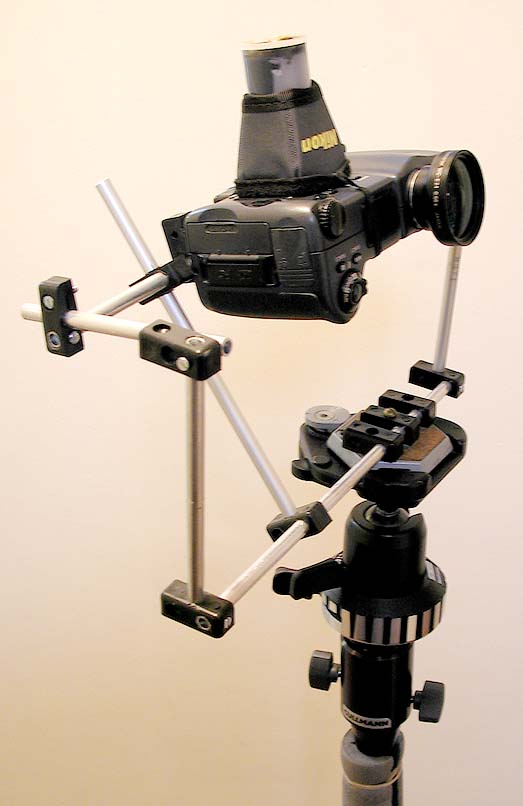 |
Starting from the top...
An LCD screen magnifier, made from a 35mm film-can with a weak magnifying
lens glued into the top, which is then slid into the standard Nikon screen
shade hood.
Next the 990 with a wide angle lens.
The 'rig' is a homemade panorama mount.
Made from off the shelf tubing and DIY brackets. Although it took a
little while to construct, the pre-drilled plastic blocks ensure that the
alignment is 100% accurate.
This contraption is only really
necessary for close-up panoramas where it is critical that the camera
moves around the nodal point of the lens to avoid parallax - see here
to determine it. If you really want to make one, drop me a line and
I'll give you more details.
A Manfrotto quick release ball and socket head mounted on a heavy duty
Cullmann ball and socket head - thus ensuring that I can place a camera in
any position regardless of how I position the Benbo tripod.
These Benbo tripods are an absolute must for outdoors photography, especially macro
shots of fungi and wild flowers when the ground is not even and when you
have to get really low for the shots. They have the advantage, over
all other tripods, that the leg angle can be varied (not fixed at 120
degrees apart) and of course the centre column can be swivelled just like
the Gitzo model.
Right at the bottom is some central-heating pipe lagging to cushion my
shoulder when carrying the tripod! |
|
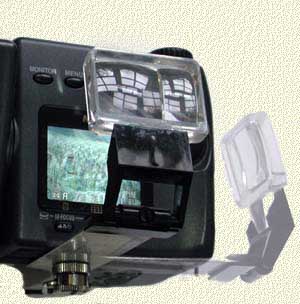
|
Here is another simple magnifier - just an old magnifier lens on an arm
which can pivot. The lens just swings out of the way when not in
use. |
|
Did you know that you can use binoculars, a monocular or
telescope as
a telephoto lens on a compact camera? use an ancient Glanz 7x40
monocular which is very effective and gives me an 800mm (35 equivalent)
lens.
Alternatively EagleEye (on the right) make superb optical zooms. Ideally put the camera into Macro
focus mode.
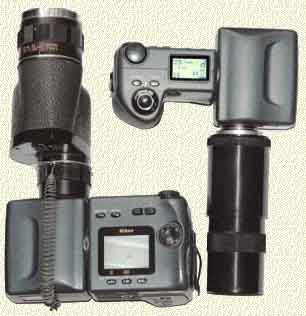 |
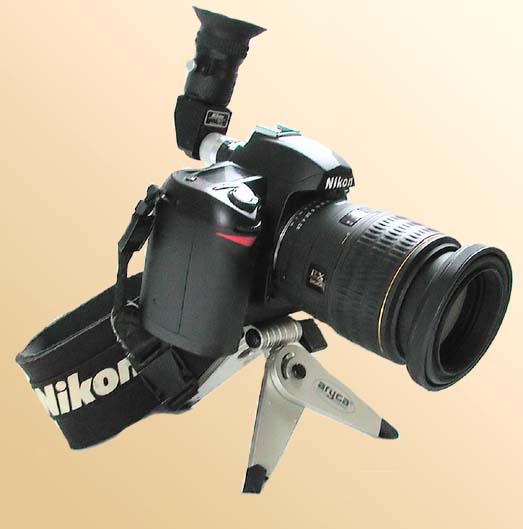 |
Here is my D70, with a right-angle eyepiece, which an an
absolute boon when taking pictures close to the ground.
The Sigma 105mm macro lens has a rubber hood on it so that it does not
take up so much room in my holster, which I find more convenient than a
camera bag when out in the woods.
You will notice that the camera is quite happy on a (silly?) little
tripod - an aryca, very lightweight and strong.
It is actually an extremely well designed bit of kit and folds flat into
15x5x1.5cm, so that it is easy to carry in ones pocket. Again I find
it extremely useful for either camera.
I also tend to carry a Polarising and some Neutral Density filters as
well as spare batteries and flash cards. A couple of
lenses, an extension tube and a Flash gun completes my normal gear when
out and about. Plus the all important umbrella hat.
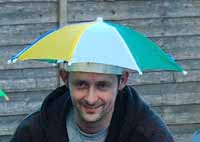
- tastefully modelled by my son! |
| For those of you who have not see a standard
Benbo Tripod (see below), it is extremely rigid - notice the diameter of the legs
(3.5 cms - compare them to
the camera body), almost twice the diameter of the Trekker ones.
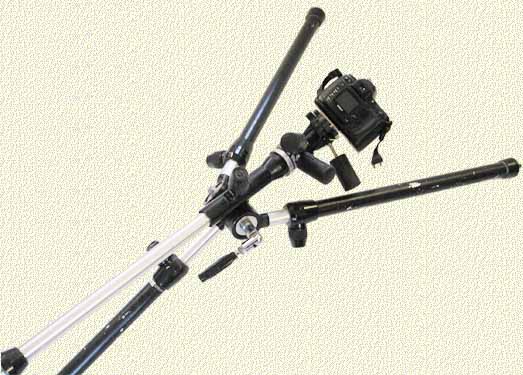
|
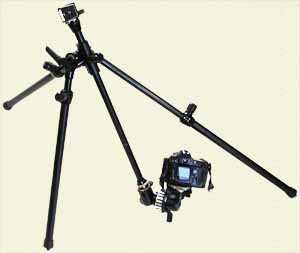
The light-weight Trekker can be carried all day and can get into any position. It is designed specifically for the outdoor
photographer and ticks all
the right boxes, with sealed, spiked legs offering full waterproofing, and
a
remarkable column that can take your camera even below ground level.
Some people find it difficult to set these up as it is based on the old
Bren gun stand with a bent bolt to allow the legs to take up any position,
but I think they are great.
|
The Nikon 990 has slightly more magnification than the D70 at 1:1 macro and
much more depth of field, but one does not get the same sense of being 'at one'
with the picture as one does looking through the eyepiece of a SLR. The
working distance for the 990 at maximum magnification is 2 cms (from the front
of the lens) compared to 10cms for the 105mm lens. If you are interested
in macro photography and do not want to buy a macro lens, then a pretty good
option is to use extension tubes (with electrically contacts) on your normal
zoom lens - you will probably only get half-size macro, but if is much cheaper
than buying a lens (even second hand). I used this combination on my F80
with a 70-300mm zoom for over a year before I decided to buy a dedicated macro lens.
I must say that my Nikon SB-600 flash gun is absolutely marvellous - I had thought that
Nikon flash guns were a bit of a rip off - but it is superb in both normal and
macro work. I especially like the fast refresh rate and the remote
wireless capability with i-TTL - makes using flash a doodle.
Before deciding which digital cameras to buy I read as many reviews as
possible, this is well worth the read before you buy
and also Steve's reviews.
Taking pictures has always been fun, but today with the digital darkroom, and
no more messy chemicals, we get a second chance to be creative - a double
delight and a great time to experiment and learn. Please use my
Photoshop Actions if it would help you with the odd photo.
Years (2012) have moved on since I first wrote this page (2006).
Digital cameras are getting better and better each release. I have now
'upgraded' ...
the Coolpix 990 to a Coolpix 4500 (an enhanced version) and this is still a
fantastic camera for taking macro photos while out walking
the D70 to a D700 - absolutely lovely to be back using a full-frame again
and this camera (bar a limited bracketing interval) is a pleasure to use
I have added a Coolpix P7000 as a pocket camera and still use the eye-piece
a lot of the time as I feel more at one with the shot than viewing a screen
and having to put my glasses on and shaking the camera at arms length!
How well do these cameras perform? - well I did a
few experiments here to see if I could change my
'bad' shooting practices and perhaps improve.
Finally when you go away, consider taking a number of smaller Flash Cards,
rather than one big one, as if your camera is lost, or the card fails, you will
at least have some of your pictures left. On holiday you could also take some blank
CDs and a Card Reader and pop into an Internet Cafe and burn them.
|
|